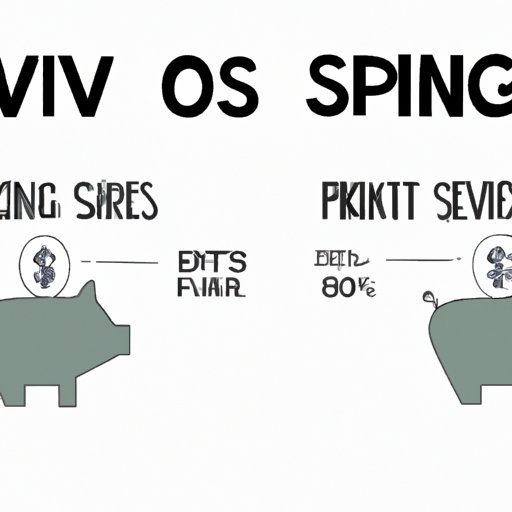Introduction
Saving and investing are two of the most important components of personal finance. Understanding the differences between these two concepts is essential to making sound financial decisions. This article will discuss the key differences between savings and investments, the pros and cons of each, and how to determine which is the right choice for you.

Comparing the Pros and Cons of Saving vs Investing
When it comes to saving and investing, there are both pros and cons to consider. It’s important to understand each in order to make the best decision for your financial future.
Advantages and Disadvantages of Saving
The primary advantage of saving is that it is a relatively safe way to store funds for short-term use. Savings accounts typically offer FDIC insurance, meaning that your money is protected up to a certain amount if the bank fails. Additionally, savings accounts often provide more liquidity than other forms of investments, allowing you to access your money quickly when needed.
On the downside, savings accounts often have lower returns than other forms of investments. According to a recent report from the Federal Reserve, the average annual percentage yield (APY) on a savings account was 0.06% in 2020. In comparison, the S&P 500 index had an average return of 11.92% during the same period.
Advantages and Disadvantages of Investing
The biggest advantage of investing is that it has the potential to generate higher returns than other forms of savings. Over the long term, stocks and bonds have historically provided much higher returns than savings accounts. For example, the S&P 500 has averaged an annualized return of 10% since its inception in 1926.
However, investing also carries greater risk than saving. Investing in stocks and bonds can be volatile, meaning that the value of your investments can go up or down significantly in a short period of time. Additionally, there is no guarantee that your investments will generate a return. It is possible to lose money when investing.
A Guide to Understanding the Different Benefits of Saving and Investing
Now that we’ve discussed the advantages and disadvantages of both saving and investing, let’s explore the different benefits of each. Knowing the unique benefits of each can help you decide which is the best option for your financial goals.
Benefits of Saving
The main benefit of saving is that it provides a secure place to store money for short-term needs. Savings accounts are insured by the FDIC up to a certain amount, making them a safe place to store emergency funds or money for short-term expenses. Additionally, savings accounts are highly liquid, meaning that you can access your funds quickly when needed.
Benefits of Investing
The primary benefit of investing is the potential to generate higher returns than traditional savings accounts. Over the long term, stocks and bonds have historically provided much higher returns than savings accounts. Additionally, investing allows you to diversify your portfolio, reducing your risk and providing a hedge against market volatility.

Exploring the Risk Tolerance of Savings vs Investment Strategies
In addition to understanding the different benefits of saving and investing, it’s important to understand the level of risk associated with each strategy. Knowing your risk tolerance can help you choose the best option for your financial goals.
Assessing Risk in Savings
Savings accounts are generally considered to be low-risk investments. As previously mentioned, savings accounts are FDIC insured, meaning that your money is protected up to a certain amount if the bank fails. Additionally, the returns on savings accounts are generally low, so there is less risk of losing money.
Assessing Risk in Investments
Investing carries a higher level of risk than saving. Stocks and bonds can be volatile, meaning that their value can go up or down significantly in a short period of time. Additionally, there is no guarantee that your investments will generate a return. It is possible to lose money when investing.
Analyzing the Time Horizons for Saving and Investing
Another important factor to consider when deciding between saving and investing is the time horizon of each strategy. Knowing the length of time you have to save or invest can help you make the best decision for your financial goals.
Short-Term Savings
Savings accounts are best suited for short-term goals. Because savings accounts are highly liquid, they are ideal for storing money for emergencies or short-term expenses. Additionally, savings accounts usually have lower returns than other forms of investments, so they are not ideal for long-term goals.
Long-Term Investments
Investing is better suited for long-term goals. Over the long term, stocks and bonds have historically provided much higher returns than savings accounts. Additionally, investing allows you to diversify your portfolio, reducing your risk and providing a hedge against market volatility.
Examining the Best Asset Classes for Saving and Investing
When deciding whether to save or invest, it’s important to consider the best asset classes for each strategy. Knowing the best asset classes can help you make the best decision for your financial goals.
Best Assets for Savings
Savings accounts are the best asset class for short-term savings. Savings accounts are highly liquid, meaning that you can access your funds quickly when needed. Additionally, savings accounts are FDIC insured, meaning that your money is protected up to a certain amount if the bank fails.
Best Assets for Investments
Stocks and bonds are the best asset classes for long-term investments. Over the long term, stocks and bonds have historically provided much higher returns than savings accounts. Additionally, investing in stocks and bonds allows you to diversify your portfolio, reducing your risk and providing a hedge against market volatility.

Understanding the Tax Implications of Saving and Investing
It’s also important to consider the tax implications of each strategy. Knowing the tax implications of saving and investing can help you make the best decision for your financial goals.
Tax Implications of Savings
Interest earned on savings accounts is taxable. The amount of tax you owe depends on your income level and filing status. Additionally, some states may charge additional taxes on savings account interest.
Tax Implications of Investments
Investment gains are subject to capital gains taxes. The amount of tax you owe depends on your income level and filing status. Additionally, some states may charge additional taxes on investment gains.
Conclusion
Saving and investing are both important components of personal finance. Understanding the differences between these two concepts is essential to making sound financial decisions. This article has discussed the key differences between savings and investments, the pros and cons of each, and how to determine which is the right choice for you.
When deciding between saving and investing, it’s important to consider the advantages and disadvantages of each, the risks and benefits, and the tax implications. Additionally, knowing your risk tolerance and the length of time you have can help you make the best decision for your financial goals.
Ultimately, the best option for you will depend on your individual situation. Taking the time to weigh the pros and cons of each strategy can help you make an informed decision that is best for your financial future.
(Note: Is this article not meeting your expectations? Do you have knowledge or insights to share? Unlock new opportunities and expand your reach by joining our authors team. Click Registration to join us and share your expertise with our readers.)
